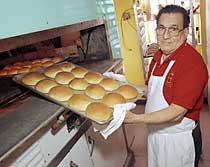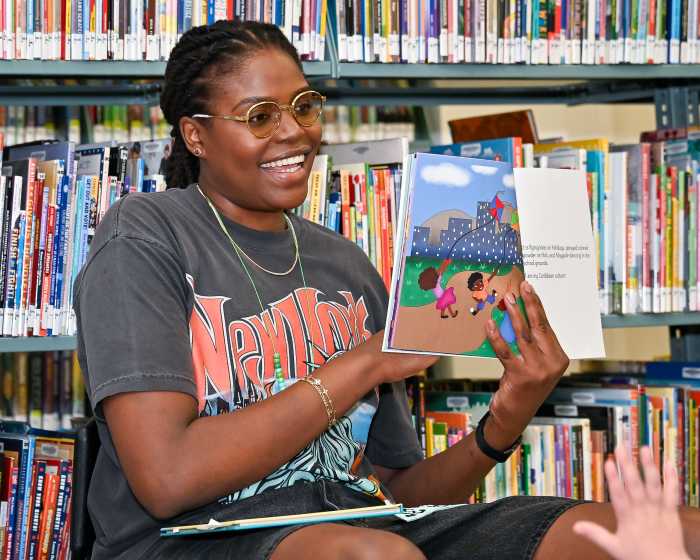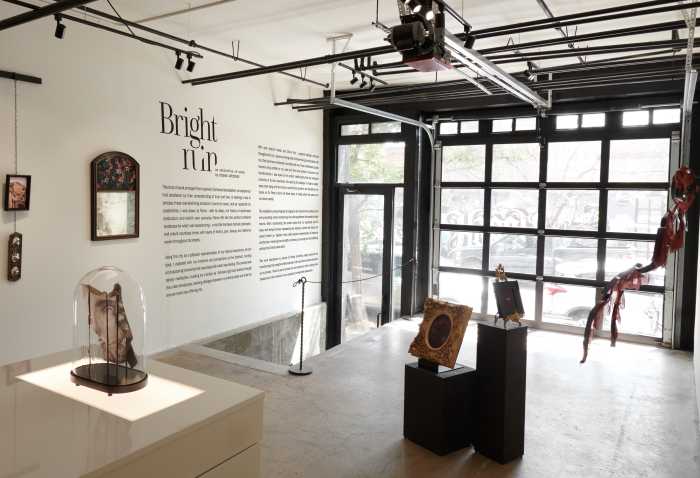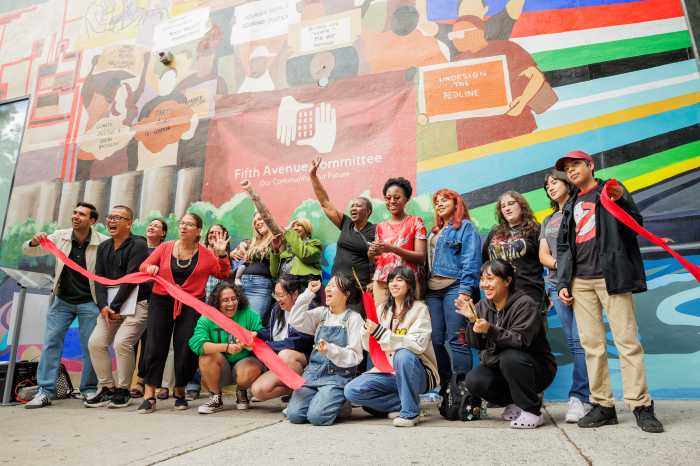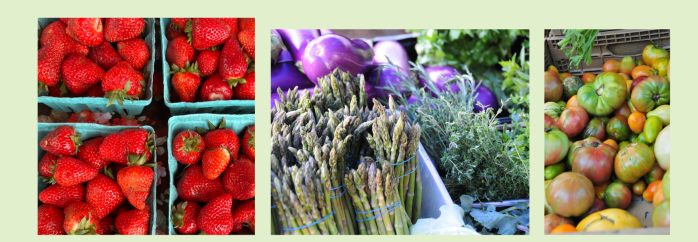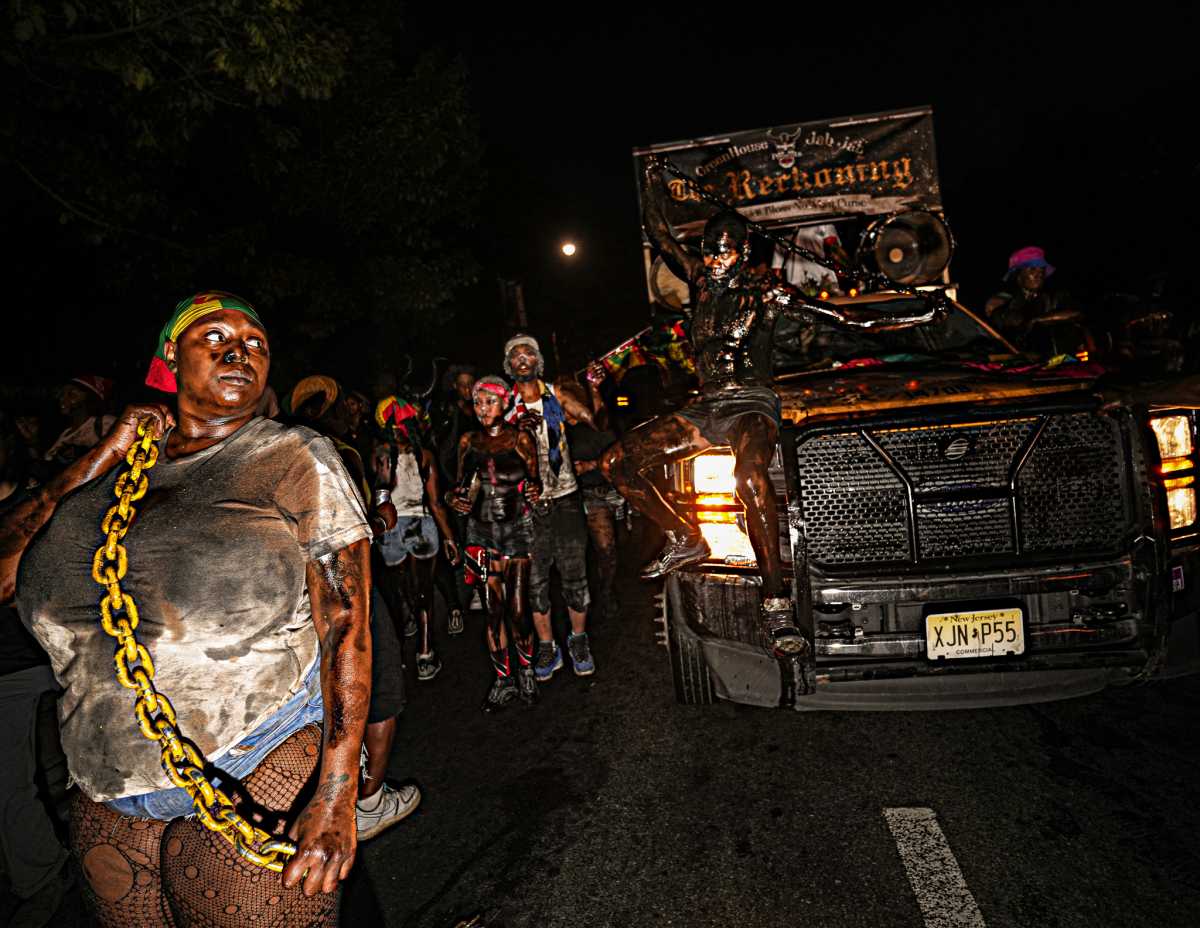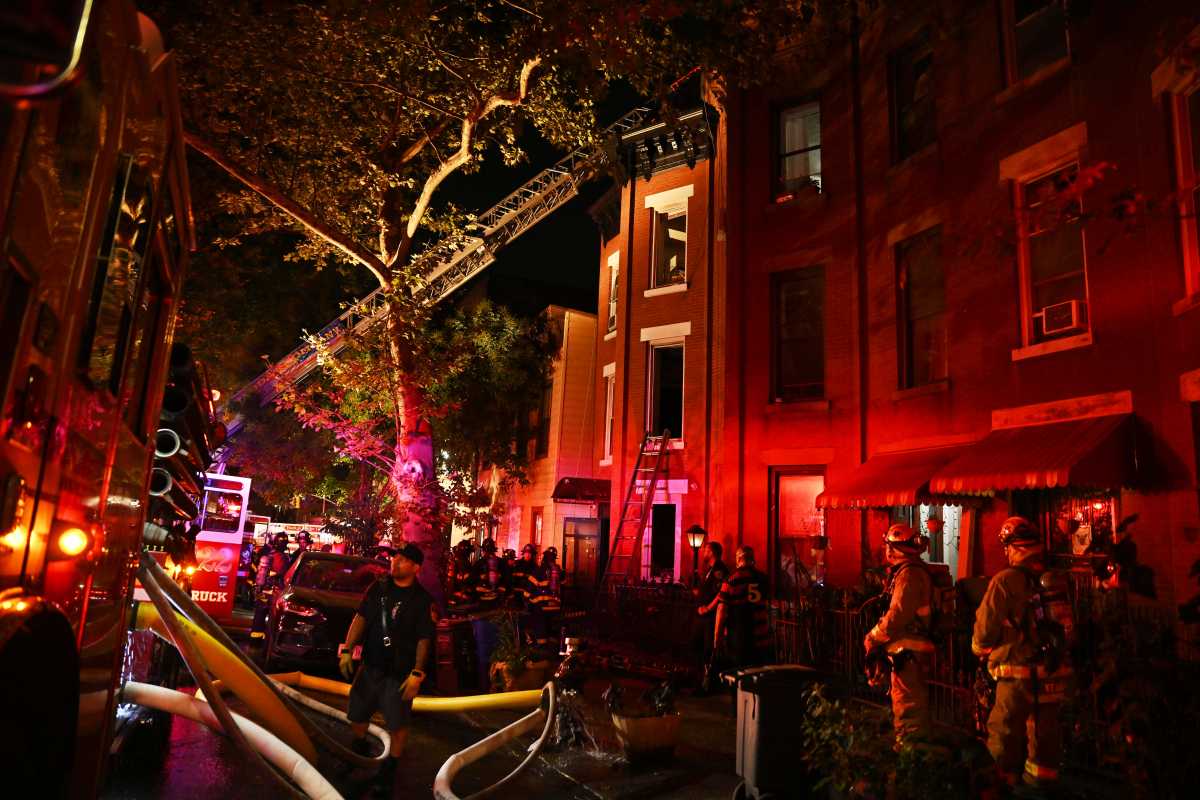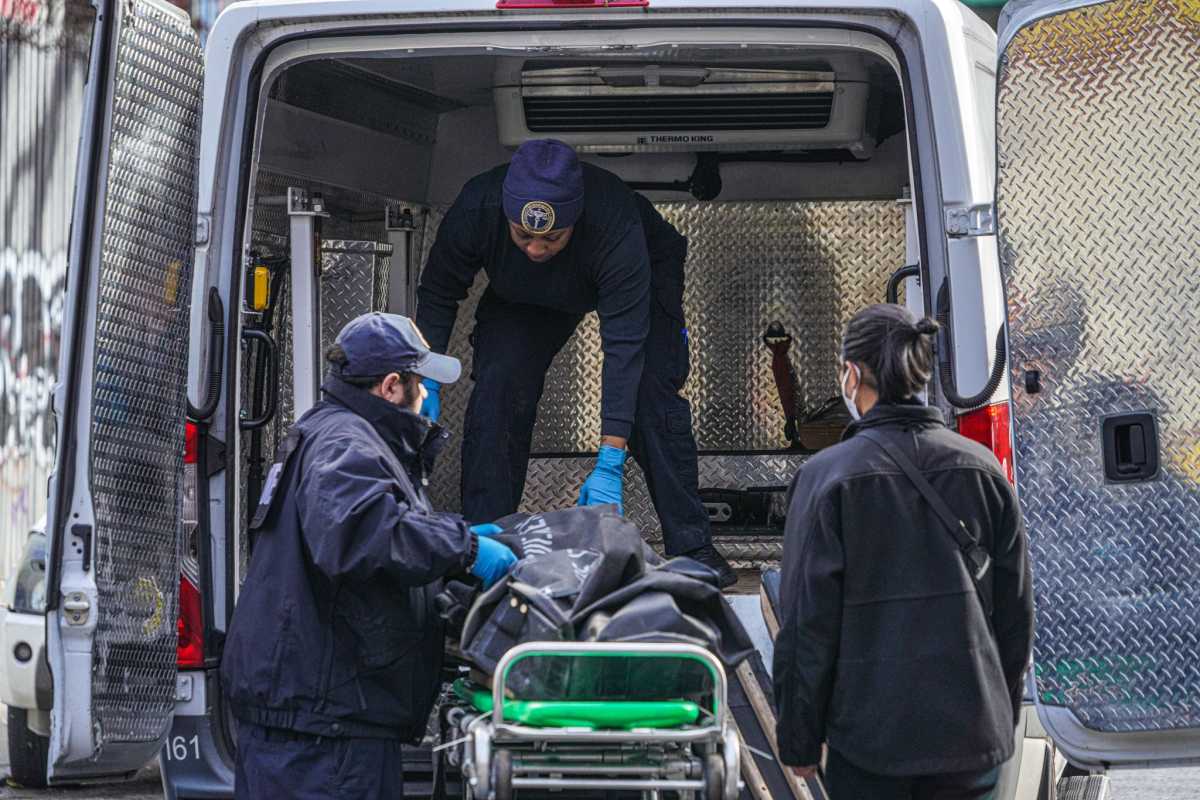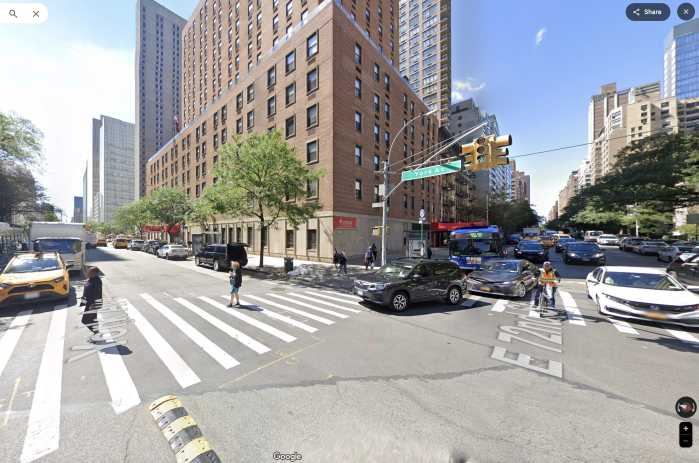In honor of the Mexican Day of the Dead
celebration, Annie Hauck-Lawson, a scholar who studies the relationship
between food and culture, led a tour through Brooklyn’s Sunset
Park, home to many Mexican immigrants.
The Oct. 26 tour, "Mexican Meals in Sunset Park," was
one of a monthly series of historical walking tours sponsored
by the Brooklyn Historical Society and held from September through
February.
About 12 foodies gathered at 41st Street and Fifth Avenue and
listened while Hauck-Lawson, an associate professor in Brooklyn
College’s health and nutrition department, described the immigrants
who have shaped this area.
Hauck-Lawson, framed by the neighborhood’s skyline and harbor
view, began the tour with a description of late-19th century
groups – mostly Scandinavian, Polish, German and Italian – who
settled along the two-mile stretch of the neighborhood’s waterfront.
"At this time," said Hauck-Lawson, "there were
German delicatessens and Scandinavian food shops with gold signs
in their windows that read, ’Norwegian food sold here.’ Until
the 1980s, you could go into some of the delis along Fifth Avenue
and Eighth Avenue and still buy the traditional fish cakes and
steamed fish puddings that were popular with the early settlers
of the area.
"[By the 1970s] immigrants from the Dominican Republic,
and New Yorkers originally from Puerto Rico, many of whom moved
here from the Bronx when that area became too crowded, moved
to Sunset Park and opened businesses," said Hauck-Lawson.
"A smaller number of Brooklynites from Honduras, and also
Mexico, moved to the neighborhood." Over the past decade
the population of Mexicans in New York City has tripled with
many Mexicans settling in Sunset Park.
From the late 1980s through the 1990s Sunset Park became home
to Asian immigrants who concentrated primarily along Eighth Avenue
creating Brooklyn’s Chinatown.
As we walked along Fifth Avenue, we noticed tamale stands set
up on the street.
"Immigrants sell specialties from their homelands that include
tamales [meat or vegetables coated with a masa (corn dough) wrapped
in a corn husk and steamed]; fresh fruit like pineapple and mango
that are cut and scored then sprinkled with salt, pepper and
chili powder; deep-fried tortillas [soft, unleavened bread made
from masa or wheat flour and lard, baked on a griddle] rolled
and filled with pork; and cotton candy," said Hauck-Lawson.
A participant commented on the groups of men seen dining together
in the taquerias (restaurants that serve burritos, tacos, quesadillas
and other authentic Mexican foods).
"The area’s restaurants become a very important social environment
for trading job information, and emotionally to ease the pain
of separation from their families and their homeland," said
Hauck-Lawson.
"The taquerias serve the sort of food the men ate in their
families’ kitchens, including tacos with a filling made from
different parts of the animal – sliced pigs ears, beef tongue
– flavors that reflect the traditional foods of the residents,
not necessarily the visiting customer."
Our walk concluded in the Don Paco Lopez Panaderia, on Fourth
Avenue at 47th Street. Once inside the bustling shop, which includes
a bakery, grocery and small restaurant, we were met with the
spicy aroma of chiles and the warm, yeasty scent of bread baking.
In the grocery area of the shop, an altar commemorating Dia de
los Muertos, or Day of the Dead, which takes place on Nov. 1
and Nov. 2, had been erected in memory of the Lopez’s deceased
family and friends.
Paco Lopez, the son of Don Paco Lopez, who owns the store, described
the holiday: "Families set out an altar decorated with food
and fruits of the region – some people include oranges, tangerines
and apples. Sometimes there is sugar cane, sometimes cigarettes
and liquor if that is what the dead person enjoyed. There are,
of course, candles and framed photographs of the deceased. We
also decorate the altar with flowers. Typical flowers found on
Day of the Dead altars are marigolds and chrysanthemums.
"We believe that the intensity of the color will guide the
dead back home safely," said Lopez.
Hanging across the grocery area of the store like brightly colored
garments on a clothes line, were intricately cut squares of paper
in fuchsia, red, electric blue and bright yellow that traditionally
decorate homes and businesses during the Day of the Dead celebration.
"The Day of the Dead is a very enjoyable day," continued
Lopez. "In the evening, people wait in the cemeteries talking,
joking and singing. Food is laid out. It is a nice celebration."
Another holiday decoration are edible skulls made from sugar.
A small mold is made in the shape of a skull, and then sugar
and water are heated until syrup is formed, poured into the mold
and hardened. After the sugar has dried the mold is opened, and
the skull is painted a bright color.
"In Mexico," said Lopez, "it is typical to find
skulls with the names of the dead painted on them."
Don Paco Lopez’s panaderia, or "bakery," produces special
breads and other baked goods for the occasion.
The pan de muertos, or "bread of the dead," is a round
loaf with a crisscrossed design on its surface that resembles
bones.
"The bread changes from town to town," said Lopez.
"Some people like their pan de muertos covered with sesame
seeds; others prefer it with red sugar."
In business for 12 years, with a branch on 116th Street and Third
Avenue in Manhattan, Don Paco has grown from a small bakery where
locals could also buy tamales, to an operation that includes
the large, spotless bakery where we watched five men spread a
mixture of lard and sugar over the tops of rolls.
"They are delicious after they’re baked," said Lopez.
"Believe me."
In the grocery area a shopper can find all manner of dried spices
and chiles and a variety of imported canned and jarred goods;
and in the restaurant a diner can sit on a stool along one long
counter and enjoy authentic Mexican snacks.
Lopez is nostalgic for the store’s early years.
"My mother made tamales that were truly great. People lined
up around the street for them," said Lopez.
In addition to tamales, which are now served only on Saturdays
and Sundays, Don Paco sells sandwiches called tortas. A torta
is a round, yeasty roll filled with chicken and a mole sauce
(spices, ground pumpkin or sesame seeds and unsweetened chocolate)
and can be topped with mayonnaise, tomatoes and jalapeno peppers.
Authentic chiles rellenos [a poblano pepper stuffed with a mild
cheese (queso fresco), battered and fried], is a specialty of
the restaurant.
We concluded the tour with superb cups of strong coffee and champurrado
a hot, roasted, blue cornmeal and chocolate drink.
The next step
Upcoming Brooklyn Historical Society Walks & Talks include:
Dec. 15, "Saturday Night Fever Revisited," a walk through
Bay Ridge led by architectural historian Francis Morrone; Jan.
15, "Inside The Arab-American community in Brooklyn,"
that begins with a demonstration of pita bread making at the
Damascus bakery on Atlantic Avenue, then continues a few doors
down at Sahadi’s where owner Charlie Sahadi will discuss the
growth of the Arab-American community in this borough; and on
Sunday, Feb. 2, "Bringing Africa to Fort Greene," wherein
a member of the Brooklyn Historical Society will lead the group
on a tour of stores along Fulton Street where merchants have
interpreted the arts of Africa in contemporary home decor and
fashion. The tour finishes with snacks at Keur n’ Deye, a Senegalese
restaurant.
Don Paco Lopez Panaderia is located
at 4703 Fourth Ave. between 47th and 48th streets. For more information,
call (718) 492-7443. Cash only.
To attend a Walks & Talks event or for more information about
The Brooklyn Historical Society call (718) 222-4111 or visit
www.brooklynhistory.org.


